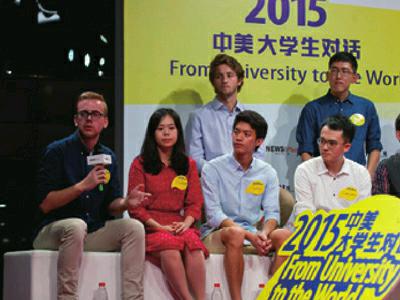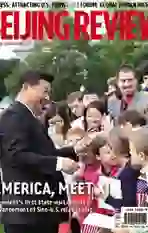NEW MODEL,NEW MOMENTUM
2015-10-22ByBaiShi
By+Bai+Shi
Politicians, scholars and commentators may have varying opinions concerning Chinese President Xi Jinpings state visit to the United States from September 22 to 25 and his first formal visit to the UN headquarters from September 26 to 28.
But one thing about which there can be no ambiguity is the message delivered by the Chinese leader during his weeklong diplomatic trip—China is committed to peace and pros- perity in the Asia-Pacific region and intends to contribute further to the international good. It does not want to be seen as a regional adversary or a challenger to the current world order.

The summit between Xi and U.S.President Barack Obama occurred “at a critical time when Chinas rise both as a global economic power and as a political power—and prospectively in terms of its military capabilities—makes the dynamics of this relationship different than they have been for decades previously,” said Kevin Rudd, Asia Society Policy Institute President and former Australian Prime Minister.
A significant visit
President Xis visit to the United States took place at a time of both high expectations and profound misunderstandings between the two countries.
The former may best characterize the mood of individuals from industrial and business sectors who no doubt relish the opportunities that may arise from Chinas development.
The present crop of U.S. presidential candidates, however, have taken a tough stance on many of Chinas policies, such as those relating to the South China Sea, cybersecurity and international norms. Presidential hopefuls are necessarily adept at stirring controversy and stoking debate. Xis trip provided them with the ideal opportunity to appear strong and assertive on China-related issues.
“I could feel how fierce the debate on China was when I visited Washington, D.C. in late August. Some scholars were expressing concerns over present frictions in the Sino-U.S. relationship,” said Ruan Zongze, Vice President of China Institute of International Studies, at a press conference in Beijing prior to Xis U.S. visit.
In spite of the heated discourse, both Chinese and Americans admit that the bilateral relationship is undergoing a sea change, with Chinas strength on the ascent and the world facing new global challenges. Thus, how to deal with a stronger China has long been a pressing topic in U.S. political, economic and military circles. Likewise, their Chinese equivalents are devoting ample time to promoting healthier and more stable relations with the United States so as to set matters on a more constructive course.
“Currently, the China-U.S. relationship has entered a transitional period and Chinas reform drive is undergoing a critical stage,”said Su Ge, President of the China Institute of International Studies, at the 14th Lanting Forum hosted by Chinas Ministry of Foreign Affairs on September 16.
“As this is President Xis first state visit to the United States, he will hope to bolster trust and address misgivings between China and the United States, given that frictions between them have the propensity to undermine both countries interests and affect both negatively,”Su said.
Today, Sino-U.S. ties have entered a pivotal point in their evolution, Ruan said, adding that China is no longer playing a passive role in matters and that its leaders have proposed ideas as to how best steer the future course of the bilateral relationship.

Mutual trust needed
As early as 2012, the fourth round of the China-U.S. Strategic and Economic Dialogue was themed along the lines of building a new model for the relationship between China and the United States. According to this paradigm, seeking mutually beneficial outcomes through cooperation should lie at the core of promoting interactions between the two countries.
In the last two meetings between Xi and Obama, held respectively at Sunnylands Estate in California in 2013 and in Beijing in 2014, the two leaders agreed on a blueprint for building the new relationship model.
In their talks at Sunnylands Estate, Xi made it clear that “the broad Pacific Ocean is vast enough to embrace both China and the United States.”
During his visit in Beijing last year, Obama stressed that the United States welcomes the prospect of a prosperous, peaceful and stable China.
However, tensions have been mounting ever since the United States first implemented its “pivot to Asia” strategy in 2010.
“These conflicts can be attributed to one central concern,” Ruan said. “Many in the United States believe that Chinas development will engender a zero-sum situation for China and the United States.”
Ruan pointed out that as China has become stronger, Obama has urged Beijing to shoulder more obligations in global governance terms. But whenever China puts forth its ideas on reforming existing international economic and financial institutions, it stokes some American politicians fears that Chinas increasing influence might undermine U.S. dominance in world affairs, he noted.
“The behavior of China in engaging with[the United States]—the incumbent economic leader—on how to reshape, strengthen, and adjust international economic norms is going to be something of a contest of ideas,”contended Daniel H. Rosen, a China-focused economic analyst and founding partner at the Rhodium Group, at an event hosted by the Asia Society Policy Institute in New York City on September 23.
“I think what stands out though at the moment is that there are questions of confidence arising about the Chinese side of that equation,”Rosen said.
But for Ruan, Chinas development would only bring about more opportunities for cooperation between the two countries. He said that over the past three decades, China has benefited from the current international system while endeavoring to make a greater contribution to global governance. Therefore, he concluded, China has no reason to challenge the current system nor attempt to build an entirely different system.
“The major principle for building a new model of Sino-U.S. relationship is to hold parties back from confrontation and conflict while seeking to resolve disputes through peaceful means based on consultation and cooperation,” Su said.
Su was of the opinion that with respect to current frictions, the two sides should implement better control and accommodate each others core interests.
In this era of globalization, he said, consensus has been reached among the international community concerning the need for cooperation. More importantly, he warned, China and the United States should not fall into the old trap of believing that an emerging power will necessarily confront a more dominant country in order to prove its strength. That narrative is better left in centuries past.
The facts would seem to bear out Sus assertions. So far, China and the United States have maintained high-level exchanges and opened more channels of communication. Over 90 intergovernmental dialogues and cooperation mechanisms have been organized, according to the Chinese foreign ministry.
Cooperation is key
Despite frictions on a number of issues, China and the United States have maintained strong momentum in the pursuit of cooperation across a wide range of areas.
During the seventh round of the China-U.S. Strategic and Economic Dialogue held in Washington, D.C. on June 22-24, the two sides reached as many as 127 deals in nine areas, from bilateral ties, climate change, energy, maritime affairs, the environment and agriculture to science and technology.
According to statistics from Chinas Ministry of Commerce, in the decades following the establishment of their diplomatic ties in 1979, bilateral trade between China and the United States has grown from nil to $555.1 billion. Twoway investment has also increased to more than $120 billion. Chinese companies have since invested directly in 45 American states.
In a letter to both Chinese and U.S. leaders in mid-September, a total of 94 U.S. CEOs called on the two governments to reach agreement on a bilateral investment treaty (BIT) by yearend. The ongoing China-U.S. BIT talks have entered their second phase, with consultation on a negative list, which specifies sectors off-limits to investors, now the primary focus.
Jeremy R. Haft, an adjunct professor at Georgetown University, has been starting up and building companies across the breadth of Chinas economy for two decades.
Haft said that Chinas manufacturing sector is facing tough challenges, with overall economic growth slowing down, and that this trend may last for years.
“But current reform is a good sign. It shows Chinese leadership has active intent to improve the countrys economic system and it should be carried out in a deeper way,” Haft said.
He admitted that Chinas economic growth slowdown presents both challenges and opportunities for the United States on some level.“As Chinas exports shrink, more countries might seek stable production exporters from America. But the two giant powers have formed a close partnership in every aspect. Therefore, the economic situation in China inevitably influences America. The urgent task for the Chinese Government is conducting effective reform in investment fields, so as to guarantee capital can flow into areas bringing momentum to the countrys economy,” Haft said.
Christopher Hassall, former Vice President of Procter & Gamble, said that under the current circumstance of global economic recession, the slower growth of the Chinese economy is understandable and not an existential threat.
Hassall pointed out that at present, Chinas reform has achieved some progress and that the country has taken steps to maintain growth. He opined that measures including Chinas initiatives for building an economic belt along the Silk Road route and the establishment of the Asian Infrastructure Investment Bank will facilitate the countrys reform and economic growth in many other countries.
Apart from the economy, Hassall thinks that China should implement reform in education and make it more innovation-oriented. He said that creativity is vital for a countrys development and that it is also an important factor in keeping the United States prosperous and economically vigorous.
According to Ruan, expectations for cooperation between China and the United States continue to run high as the Sino-U.S. relations have gone beyond bilateral concerns and now have a significant influence on global issues.
Since the outbreak of the global financial crisis of 2008, China and other emerging economies have stepped up to the plate, together forming a new engine for global economic growth. In the meantime, at their successive meetings, Chinese and U.S. leaders have expressed their willingness to let China and the United States, the largest developing and developed economies in the world, work together toward a healthy and stable global economy.
Wang Yizhou, Deputy Dean of the School of International Studies, Peking University, agreed, saying that cooperation between China and the United States is a prerequisite for effective global governance going forward.
As it stands, China is a member of almost all of the worlds intergovernmental organizations and has signed the dotted line on over 400 international multilateral treaties.
Wang pointed out that Sino-U.S. cooperation can be evident in many international and regional affairs, not least in hot-button issues concerning Iran, North Korea and Afghanistan. He added that China is making efforts to contribute more to dealing with global challenges ranging from climate change and counterterrorism to peace-keeping and poverty reduction and development.
He contended that if implemented, Xis proposals for building a new model of major country relationship and promoting a fair and equitable international order will prove beneficial to the world at large.
